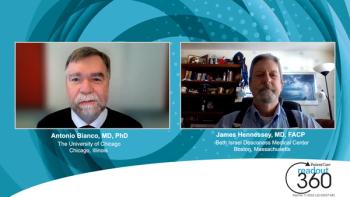
Prevalence of Subclinical vs Overt Hypothyroidism
Drs James Hennessey and Antonio Bianco examine the differences in prevalence between overt and subclinical hypothyroidism.
Episodes in this series

Antonio Bianco, MD, PhD: Let me stop you there. I saw a paper that you published the other day, and it talked about subclinical hypothyroidism, and I was surprised by the prevalence that there was between 1% and 17%. Talk to me a little bit about that. I didn’t realize subclinical hypothyroidism was such a prevalent condition that we see up to 17% of the population. Obviously, it’s probably more frequent in older individuals and in women, but still, 17% is a big number. How do you see this compared to overt hypothyroidism?
James Hennessey, MD, FACP: I agree with you that the subclinical hypothyroidism prevalence is quite alarming or surprising, depending upon your view, but overt hypothyroidism accounts for about 1% of the hypothyroidism that we deal with.
Antonio Bianco, MD, PhD: I see. Of course.
James Hennessey, MD, FACP: The remainder of the hypothyroidism is subclinical. I always like to remind myself that the overt patients are those with the elevated TSH [thyroid-stimulating hormone] and a low 3T4 and usually have quite prominent symptoms that I expect to resolve with thyroxin therapy if I treat them. On the other hand, people with subclinical hypothyroidism, which dominates the total population, are defined biochemically with an elevated TSH and a normal 3T4, and they’re less likely to have associated symptoms. The paradox here is, many of them have some sort of nonspecific symptoms.
Antonio Bianco, MD, PhD: Of course, because they’re so common, who doesn’t have dry skin, constipation, or hair loss. Yes, those symptoms are very nonspecific and common.
James Hennessey, MD, FACP: That’s why we always say, if it’s hypothyroidism, I think I can fix this because we’ve got over 100 cases worth of experience in doing that. We order thyroid function tests, and one of the things that I’ve become increasingly aware of is that I’m not aware of any clinical laboratories that are using age-adjusted TSH value to appropriately diagnose subclinical hypothyroidism in older people. As Marty Surks, MD, and Joe Halliwell showed several years ago, as the decades go on, the levels go up.
Antonio Bianco, MD, PhD: What’s the rule of thumb? Every 10 years, you increased by one the norm?
James Hennessey, MD, FACP: Yes. There’s guidelines out of Europe saying to take the person’s age and divide it by 10. That’s probably where the upper limit of normal should be.
Transcript edited for clarity
Newsletter
Enhance your clinical practice with the Patient Care newsletter, offering the latest evidence-based guidelines, diagnostic insights, and treatment strategies for primary care physicians.





